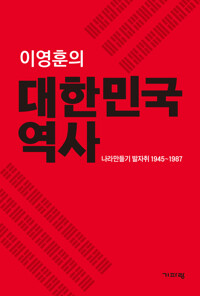
단행본
The Korean Demilitarized Zone: The History and Legacy of the Border between North and South Korea
- 발행사항
- [USA] : Charles River Editors, [발행년미상]
- 형태사항
- 98 p. : ill. ; 28 cm
- ISBN
- 9781979528849
- 청구기호
- 911 C477k
소장정보
| 위치 | 등록번호 | 청구기호 / 출력 | 상태 | 반납예정일 |
|---|---|---|---|---|
이용 가능 (1) | ||||
| 1자료실 | 00017692 | 대출가능 | - | |
이용 가능 (1)
- 등록번호
- 00017692
- 상태/반납예정일
- 대출가능
- -
- 위치/청구기호(출력)
- 1자료실
책 소개
*Includes pictures
*Includes accounts describing the DMZ
*Includes online resources and a bibliography for further reading
During the Moscow Conference in December 1945, the victorious Allies agreed that the United States, the Soviet Union, Great Britain, and the Republic of China would hold equal shares of control over the Korean Peninsula for up to 5 years before allowing Korea its independence. Most locals, barring the Soviet-endorsed Communist Party, opposed the trusteeship immediately. Apprehensive of another civilian insurrection, Soviet and American officials brokered talks to merge the administrations, but its progress was hindered by trouble brewed by the restless locals, as well as the tension that reached a crescendo in the impending Cold War.
In the meantime, the enmity between the north and the south continued to sour. Those displeased by their local politics, as well as those who predicted the forthcoming cataclysm, hopped the border before it was too late. By May of 1946, authorities on both ends declared that anyone else who dared cross the 38th parallel without a permit would be guilty of trespassing and duly penalized for their crime.
The Korean War was a watershed event for a number of reasons. Not only was it considered the first military action of the Cold War, as well as one of the first to utilize jet planes kitted out with bombs and missiles, the United Nations immersed itself in the precarious politics of warfare for the very first time. A total of 41 countries gifted shiploads of provisions and equipment to South Korea. Another 16 countries provided their own soldiers to serve as backup for the South Koreans. Their mission, put simply, was to extinguish Communism on the peninsula once and for all.
After a series of heated, but unproductive negotiations that lasted 2 brutal years and 17 miserable days, North Korea and South Korea found themselves locked in a stalemate. Finally, on July 27, 1953, representatives from both parties gathered at the village of Panmunjom, located on a semi-neutral zone by the border. Here, they devised a document entitled the “Korean Armistice Agreement,” and scrawled their names across the bottom of the parchment, calling for a ceasefire, effective immediately. In essence, this agreement was no more than a truce, for there were no victors. The agreement merely ensured “a suspension of open hostilities,” a “transfer of POWs,” and lastly, the formal establishment of the demilitarization zone, better known as the “DMZ.” To this day, no peace treaty has ever been signed.
Despite the fact the border between North Korea and South Korea remains tense, and former President Bill Clinton once branded it the “scariest place on Earth,” more than 7.5 million tourists have visited the notorious demilitarized zone for one reason or another. There, they gazed upon a treacherous, but evidently intriguing strip of land, guarded by estranged brothers with a chilling array of weapons directed at one another at all times.
The Korean Demilitarized Zone: The History and Legacy of the Border between North Korea and South Korea examines one of the most dangerous locations on the planet. Along with pictures depicting important people, places, and events, you will learn about the notorious DMZ like never before.
*Includes accounts describing the DMZ
*Includes online resources and a bibliography for further reading
During the Moscow Conference in December 1945, the victorious Allies agreed that the United States, the Soviet Union, Great Britain, and the Republic of China would hold equal shares of control over the Korean Peninsula for up to 5 years before allowing Korea its independence. Most locals, barring the Soviet-endorsed Communist Party, opposed the trusteeship immediately. Apprehensive of another civilian insurrection, Soviet and American officials brokered talks to merge the administrations, but its progress was hindered by trouble brewed by the restless locals, as well as the tension that reached a crescendo in the impending Cold War.
In the meantime, the enmity between the north and the south continued to sour. Those displeased by their local politics, as well as those who predicted the forthcoming cataclysm, hopped the border before it was too late. By May of 1946, authorities on both ends declared that anyone else who dared cross the 38th parallel without a permit would be guilty of trespassing and duly penalized for their crime.
The Korean War was a watershed event for a number of reasons. Not only was it considered the first military action of the Cold War, as well as one of the first to utilize jet planes kitted out with bombs and missiles, the United Nations immersed itself in the precarious politics of warfare for the very first time. A total of 41 countries gifted shiploads of provisions and equipment to South Korea. Another 16 countries provided their own soldiers to serve as backup for the South Koreans. Their mission, put simply, was to extinguish Communism on the peninsula once and for all.
After a series of heated, but unproductive negotiations that lasted 2 brutal years and 17 miserable days, North Korea and South Korea found themselves locked in a stalemate. Finally, on July 27, 1953, representatives from both parties gathered at the village of Panmunjom, located on a semi-neutral zone by the border. Here, they devised a document entitled the “Korean Armistice Agreement,” and scrawled their names across the bottom of the parchment, calling for a ceasefire, effective immediately. In essence, this agreement was no more than a truce, for there were no victors. The agreement merely ensured “a suspension of open hostilities,” a “transfer of POWs,” and lastly, the formal establishment of the demilitarization zone, better known as the “DMZ.” To this day, no peace treaty has ever been signed.
Despite the fact the border between North Korea and South Korea remains tense, and former President Bill Clinton once branded it the “scariest place on Earth,” more than 7.5 million tourists have visited the notorious demilitarized zone for one reason or another. There, they gazed upon a treacherous, but evidently intriguing strip of land, guarded by estranged brothers with a chilling array of weapons directed at one another at all times.
The Korean Demilitarized Zone: The History and Legacy of the Border between North Korea and South Korea examines one of the most dangerous locations on the planet. Along with pictures depicting important people, places, and events, you will learn about the notorious DMZ like never before.

